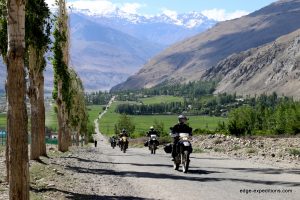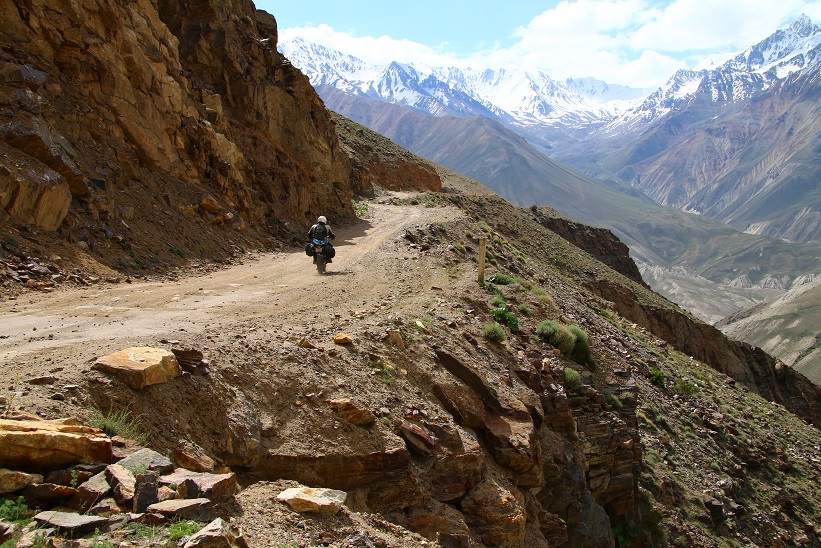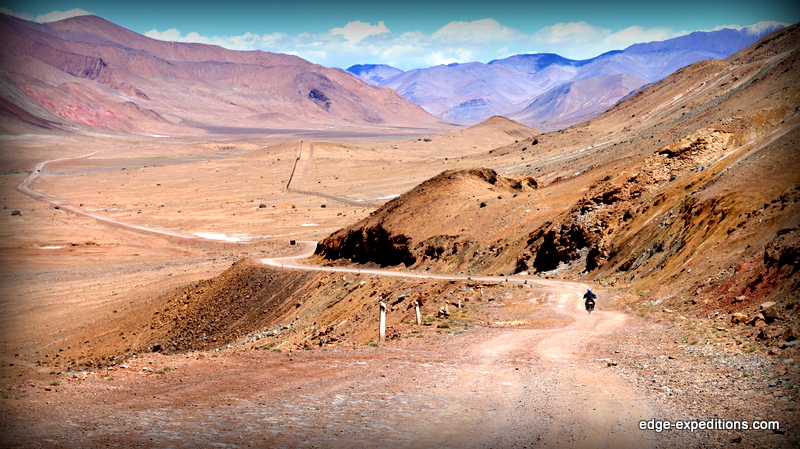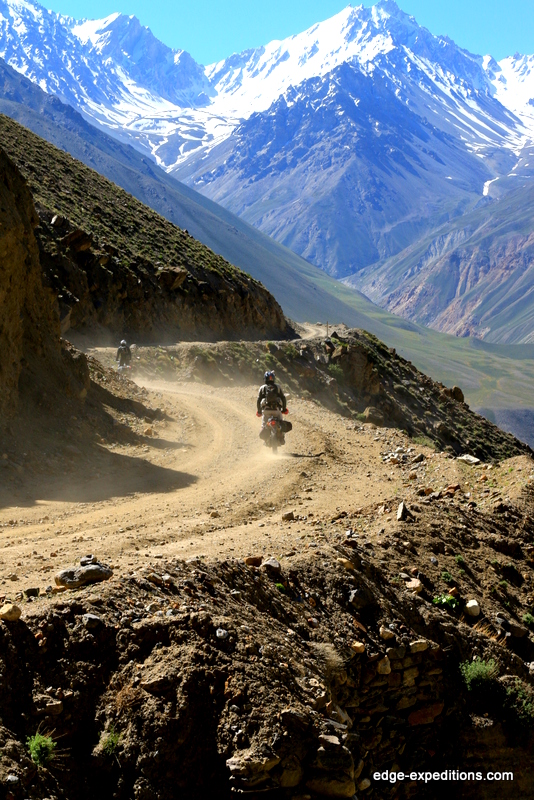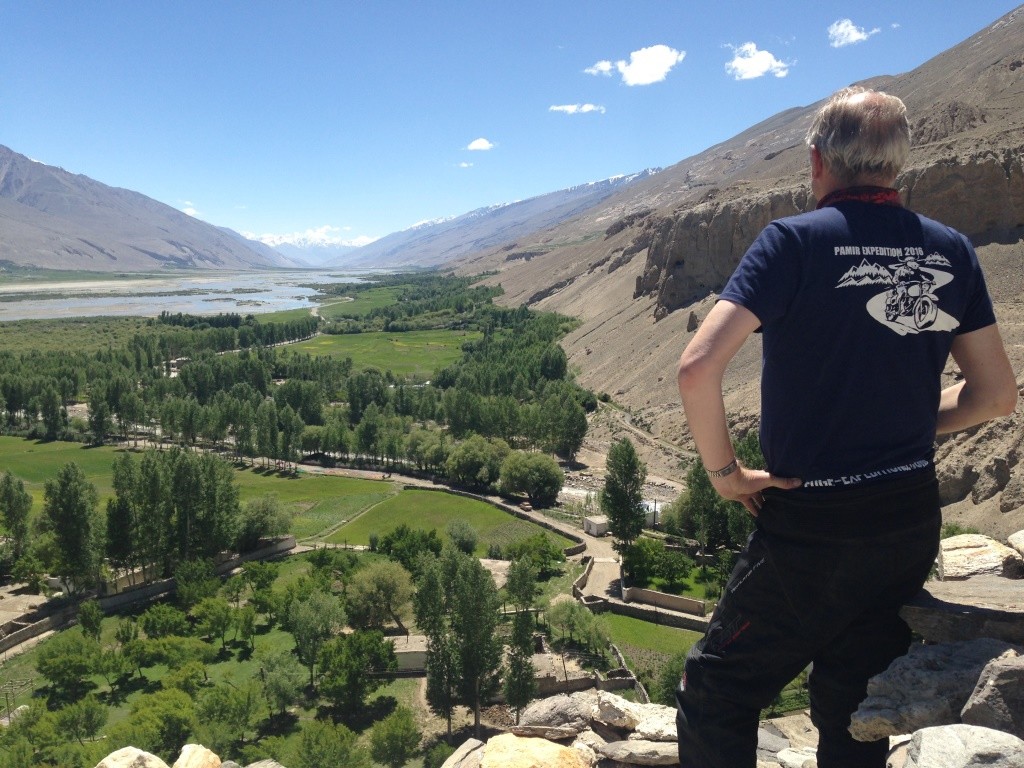OVERLAND EXPLORE Tajikistan
Explore Tajikistan and the Pamir Highway 3rd – 17th July 2017!
Riding the Pamir Highway is a truly magical experience, through stunning landscapes populated by ancient cultures. We are delighted to be working with Edge-Expeditions to bring you this great opportunity to Explore. The itinerary below can only ever be a brief guide to a journey that will stay with you forever.
THE ITINERARY

Day 1
Arrive Dushanbe International Airport, Tajikistan
Flights from the UK (Turkish Airlines via Istanbul) arrive at the rather ungodly hour of 03.35 so this will be a gentle day of sleeping, acclimatising, eating and drinking.
Lift Off! It’s chocks away as we hit the road and have an easy ride to Kala i Hussein 220 kms east of the capital.
Day 3
Kala i Hussein – Kala-i-Kumb
A thrilling (and at times chilly) 70 kms ride over the 3,852m Khaburabot Pass to Kala-i–Kumb, where we join both the mighty Panj River and the border with Afghanistan. On the way we enter Gorno Badakhshan, the autonomous province that defines the Tajik Pamirs.
Kala-i-Kumb – Khorog
We head deeper into the mountains, following the Pamir Highway and the Panj 240 kms south-east to Khorog along the Afghan border. Expect soaring eagles, stunning mountain scenery and dusty roads carved through deep river gorges.
Day 5
Khorog – Yamchun
From Khorog we continue south to Ishkashim. After this we turn east into the Wakhan Corridor, riding in the shadow of both the High Pamirs and Pakistan’s Hindu Kush. Tonight after a day’s ride of 160 kms we stay in Yamchun, home to a 2,000 year old Silk Road fortress and some extremely reviving hot springs.
Day 6
Yamchun – Langar
There’s so much to see in the Wakhan Corridor that today we just ride 40 kms to the village of Langar. On the way we climb up to Buddhist stupas, visit a great little museum and stop in some lovely Wakhi villages. The views here across to Afghanistan and Pakistan are quite something, and the family at tonight’s homestay are utterly delightful.
Day 7
Langar – Jarty Gumbez
We leave the Wakhan Corridor behind us today, and really step away from any sort of beaten track. Ordinarily, the route continues north over the Khargush pass to Alichur, but we take the rarely-used eastern track up, high along the Afghanistan border through the Zorkul Nature Reserve wetlands. We end our day at the yurt and hunting encampment of Jarty Gumbez at 4,130m, home to ancient kurgan stones, solar calendars and hot springs.
Day 8
Jarty Gumbez – Murghab
Now we really are riding on the Bam-i-Dunya, ‘the roof of the world.’ Not only that, but this corner of Tajikistan is the least visited and most far-flung, so very few outsiders ever venture here. We will have views to 4 countries – Tajikistan, Afghanistan, Pakistan and China – today, passing within 40kms of the Chinese Silk road stronghold of Tashkurgan. Up here there are numerous hot springs, ancient caravanserai from the Silk Road, meteor craters and even an abandoned soviet astrological-observatory. On a clear day, the view over to the monster pyramid peak of Mustagh Ata in China can be breathtaking. We’ll spend the night in Murghab.
Day 9
From Murghab it’s a blustery 150kms ride across the extraordinary lunar landscape of the Murghab Plateau to a yurt camp at Bulunkul. Watch out for Kyrgyz nomads, fat golden marmots and soaring eagles. On the way, we’ll have a rather special encounter with some friendly yaks and we’ll spend tonight in a Kyrgyz yurt encampment on the shores of Bulunkul Lake.
Day 10
Bulunkul – Rushan
From Bulunkul, we first traverse the 4,370m Koizetek Pass, before joining the Ghunt River, which we follow down its 130kms twisting, roaring and plunging course, to Khorog, where we once again meet the Pyanj River on its way to the Aral Sea. The road down the Ghunt valley is a set of superlatives all of its very own. At times the views can take the breath right from you, and you’ll love seeing the gradual greening of the valley after the last few days of arid landscapes. We’ll stop briefly in Khorog but our destination tonight is another 70kms along the road at Rushan, where we have a lovely homestay in which to lay our heads.
 Day 11
Day 11
Rushan – Bartang Valley – Rushan
The Bartang valley contains one of the oldest threads of the Silk Road, shown on maps from 200AD. It is little visited, being off the ‘main’ road from Dushanbe to Khorog and subject to inaccessibility due to high river levels and landslides during much of the year. Today, we will get as far along the Bartang Valley as time and circumstance allows. The road is amongst the worst in the Pamirs, as it weaves its way between the Rushan and Yazgulom mountain ranges. By now, we’ll be at one with our motorised steeds, and hopefully the day will prove to be a hugely enjoyable exploration of this remote valley. We’ll return to Rushan for a good meal at our homestay.
Rushan – Kalai-Hussain
From Rushan we follow the Pyanj back for 180kms towards Kala-i-Khumb, where we stayed on the outward leg of our trip. We will stop for refreshments here before tackling the last 55kms over the Khaburabot Pass (3,582m), dropping down to Kala-i-Hussain, where we will spend our last night on the road.
Day 13
Kala-i-Hussain – Dushanbe
Our final day’s riding – leaving Gorno-Badakshan behind us, our route today retraces our steps to Dushanbe, about 140kms away. Around lunchtime, we will find ourselves back on tarmac, which by now is going to feel pretty strange! From there it’s a couple of hours blast back to Dushanbe, where we will have cold beers awaiting you!
Day 14
Dushanbe
Day off in Dushanbe. This is one of Central Asia’s more interesting and quirky cities, and even without the architectural wonders of Bukhara or Samarkand there is plenty to see if you feel inclined. This evening there will be a farewell dinner in Dushanbe.
Day 15
Dushanbe. The suggested Turkish Airlines flight to the UK (via Istanbul) departs at another ungodly hour of 05.40. Hardly worth going to bed is it?
COSTS
This trip is competitively priced at £3,950
What this includes
Rental of a fully insured Suzuki DRZ 400 motorcycle
Soft panniers if you require them
Accommodation in a range of homestays and hotels. These will range from simple family run homestays and yurts in the mountains to 3-4* hotels in the few cities we pass through.
Most meals
Local airport transfers
Fuel
A professional guiding team including one of the Overland Magazine team, either Ants or Marley from Edge Expeditions, an English speaking Tajik guide, a top notch mechanic and a back-up vehicle with driver
Fresh filtered water
All spare parts, tools and on the roadside repairs
What it doesn’t include
International flights
Your personal riding equipment – clothing, boots, helmets, protection
Extra daily costs for snacks, alcohol or souvenirs
Your personal travel insurance including medi-evac
Visa and GBAO (Gorno-Badakhshan Oblast Administration) permit for Tajikistan
FAQ’s
Where will we be staying?
On this expedition, we’ll be staying from good hotels in Dushanbe, Khorog and Osh, guest houses or basic hotels in other towns, and more often in homestays with local people and their families. The homestay concept is widely accepted throughout Tajikistan and Kyrgyzstan – particularly the former – so these nights are often highly enjoyable glimpses into local customs and lifestyles. We also stay in yurts in a couple of locations on this trip.
What size of group will it be?
Our group sizes are always small, allowing for an intimate experience of the cultures we meet along our path. On the Pamir Highway, group sizes are dictated by the size of the homes we will be staying in. Our group is usually 8 expeditioners, a guide, mechanic, back-up driver and one member from each of the Overland Explore and Edge teams. We usually find groups are made of like-minded people, both male and female, from a wide age range, and where motorcycles are involved, this is particularly true.
Why have you chosen such small engined bikes?
In the words of our guide “the Pamir highway kills bikes”. And he should know! Our local guides have huge experience of working in these often hostile terrains, and after trying – and in most cases still owning – almost every type of bike imaginable (including the usual GS, KTM etc) have opted for the lightweight, mechanically simple and hugely robust Suzuki DRZ400. The bikes cope very well with the bumps and lumps and are comfortable both on and off the pegs. If your drop a bike, it likely won’t break and you’ll be able to pick it and yourself back up without needing a support team and a crane. We are huge fans.
What will the weather be like?
A very difficult question to answer when traversing the fourth highest mountain range on earth. But, you can expect some hot days lower in the valleys and off the high plateaus – temperatures could be in 20-30C range or higher. At altitude, we have experienced every season in the course of a single day – warm sunshine followed by winds and rain, hail or snow on the passes and perhaps down to 0 degrees for a short period of time. In general, the rule of thumb is to expect warm days and cooler nights when we are out of the lowland areas.
I’m a solo traveller – is this for me?
Yes. More than 85% of our expedition clients travel alone as part of our group. We don’t charge single supplements to solo travellers – see below.
Do you charge single supplements – I can’t see them in your information?
No. We don’t believe that solo travellers should be penalised with extra charges. It goes against our ethos, so unless totally unavoidable or astronomically expensive, all costs are included in the expedition price. Please note that in many of our destinations, single rooms are simply not available due to the nature of the available tourism infrastructure.
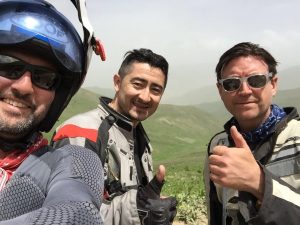 What kit do I need to bring?
What kit do I need to bring?
We will provide you with an information pack after signing up to this trip, and this will detail any particular equipment we think either necessary or useful. For this motorcycle expedition, see below for a smidge more detail.
How do I choose what to wear on the bike?
This is really a matter of personal choice, as all riders have their own modus operandi. However, our experience says that good expedition boots are very useful. We don’t tend to ride using metal-toed dirt boots, but some do. We use an adventure-style boot that allows good ankle protection and is stiff with protection on the shins. In terms of lid; we tend to favour flip-front helmets that can be lowered when cold and raised quickly to meet and greet people along the way. Although we are there during the least-rainy season we tend to use a pull-on overcoat and trousers that are kept to hand for quick access. Under these we ride in a well-ventilated and elbow/shoulder/back/knee armoured bike jacket and trousers – the better ventilated the happier you will be! As already highlighted, most riders have their own tried and tested methods. Our simplest motto would be to layer for multiple weather types.
Is there a back-up vehicle?
Yes. We will travel with a back-up 4×4, carrying filtered water and spares where necessary.
How much are flights?
This is a moving feast! It depends on where you are travelling from and how you want to get there. From London, the cheapest flights to Dushanbe might be via Moscow. We use Turkish Airlines via Istanbul because they are good, cost-effective connections. Costs are usually around the £450 mark, return.
What will the food be like?
Varied; the Pamir area is not particularly agriculturally inclined, mostly due to the precipitous nature of the topography, and often poor soils. But many of our homestay hosts pride themselves on making good meals for their guests, so we will be well looked-after. If you are a vegetarian, food can be a little dull (lots of bread, potatoes and eggs with salads) but perfectly acceptable. For meat-eaters, pilaf is the main dish. Usually rice and meat in one dish and often very tasty. Freshly made non (bread) is available almost everywhere and can be delicious. We try to ensure we have some treat foods in the back-up vehicle for picnics. In general we think food is a core part of any cultural experience and there are a good number of local dishes to try on our route.
Will I have to share a room?
Yes, at times. There will be hotels and guest houses where we will have separate rooms, but there will also be times where we are staying at homestays or in yurts when there is no option but to share rooms. This is all part of the adventure, and a reason we love to travel here. It makes sense for light sleepers to bring earplugs, in case of snorers or the host family waking early.
Will I be affected by altitude?
Altitude can affect different people in different ways. It can also affect the same person in different ways from trip to trip. We will be spending quite a number of days above 3000 metres, and up on the Alichur and Murghab plateaus, often above 4000 metres. We also cross some high passes, with the Ak Baital being 4700m (over 15,000 ft). If you feel that you might suffer from altitude sickness, or have history of it, you should consider discussing this with your doctor prior to booking and travel. Diamox and other similar prescription drugs are available to ease symptoms, but the key way to address any onset of altitude sickness is to descend. Luckily, from anywhere particularly high, descent is possible rapidly thanks to our back-up vehicle. Our route is also planned to gain altitude in the smallest increments possible to aid acclimatisation. Simple precautions and awareness go a long way.
Do you perform proper risk management on your expeditions?
Yes. We employ international risk experts Sirisk to perform our country risk assessments 1 month prior to departure. We also maintain close contact with the relevant Foreign and Commonwealth Office advice for countries we plan to visit. Beyond this, we have a full set of risk management and disaster contingency plans for each expedition and are expedition first aid trained. For final back up we also use the services of Remote Medical Support that allows us to have a UK expedition doctor on the end of a telephone line wherever we may be.




